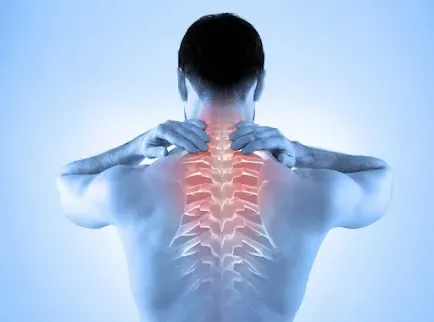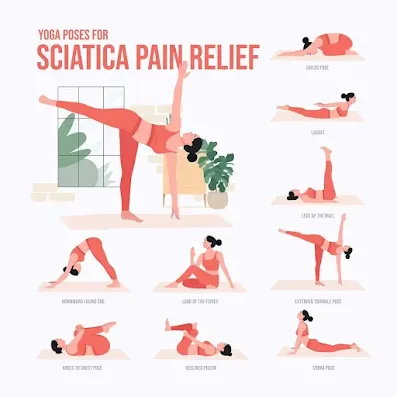Back Pain: Causes, Symptoms, Diagnosis,
Treatment, and Prevention
Introduction
Back pain is among the most popular
medical issues in the world with millions of individuals experiencing it in the
course of their lives. It can be a dull continuous pain up to a sudden sharp
pain that makes movement hard. Although the disorder of back pain usually
disappears on its own, the chronic or severe cases can be treated medically. This
is a very detailed article discussing the causes, symptoms, diagnosis,
treatment and prevention of back pains.
Causes of Back
Pain
Backache may be caused by a
combination of many factors such as strain, structure, and medical condition
and lifestyle habits. The main reasons are described below:
1. Muscle or
Ligament Strain
·
Back muscles and
ligaments may be strained by heavy lifting, awkward twists and sudden motions
and by poor postures.
·
The strain can
cause muscle spasms, which are painful.
2. Structural
Problems
·
Herniated or
Bulging Discs Herniated or
bulging discs are the soft cushions (discs) located between the vertebrae and
they can rupture and in turn bulge, exerting pressure on the nerves.
·
Arthritis: The lower back may be subject to
osteoarthritis, which may cause a spinal stenosis (narrowing of the spinal
canal).
·
Osteoporosis: There are poor and porous bones that lead to
painful spine fractures.
·
Scoliosis: The spine might be curved abnormally and this
is a factor that might cause back pain.
·
Sciatica: It is the pain that is radiated down the leg
due to sciatic nerve being compressed.
3. Medical
Conditions
·
Kidney
Stones or Infections: There can be
pain in lower back.
·
Endometriosis: The development of uterus tissue outside the
uterus will create back pains in women.
·
Tumors: Spine
tumors are not common and often they simply apply pressure on the nerves.
4. Lifestyle
Factors
·
Sedentary
Lifestyle: Muscles that are weak because of lack
of activity are risk factors of back pain.
·
Obesity: Overweight causes a burden on the spine.
·
poor
Posture: Incorrect posture or sitting
ergonomics are an agent of chronic pain.
·
Smoking: Decreases the blood flow to the spinal discs
and speeds the degeneration process.
Symptoms of Back
Pain
The symptoms of back pains differ on
the basis of the causal condition. Some typical symptoms are:
Acute Back Pain
(Short-term)
·
The sharp pain
that suddenly occurs after an injury or heavy lifting.
·
Weakness and
stiffness of muscle and restricted mobility.
·
Improving pain.
Chronic Back Pain
(Long-term)
·
Aching pain, more
than 12 weeks.
·
Pain which
increases with particular movement (bending, lifting).
·
Radiating the
pain to the legs (suggesting involvement of the nerves).
Red Flag Symptoms
(Require Immediate Medical Attention)
·
Traumatic pain
(e.g. fall or accident) with severe pain.
·
Weakness or
numbness of legs.
·
Loss of the
ability to control bowel or bladder (cauda equina syndrome).
·
Sudden weight
loss (with or without back pain) (tumor or infection).
Diagnosis of Back
Pain
Comprehensive examination in medicine
aids diagnosis of the back pain. Diagnostic procedures are:
1. Medical
History & Physical Exam
·
The physician
determines the location of pain, the extent of pain, and the precipitating
factors.
·
Tests reflexes,
muscle strength and nerve activity.
2. Imaging Tests
·
X-rays: Diagnosis
of fractures or arthritis without the damage of soft tissue.
·
MRI or CT Scans:
They will give a detailed image of the discs, nerves, and soft tissues.
·
Bone Scans:
detect the infection or tumor.
3. Lab Tests
·
Blood tests are
done to detect an infection or inflammatory disease (e.g. arthritis).
4. Nerve Studies
·
In case of
suspicion of sciatica, the electromyography (EMG) is used to gauge the nerve
functioning.
Treatment Options
for Back Pain
The nature and degree of pain
determines treatment. Options include:
1. Self-Care
& Home Remedies
·
Limited rest can
be beneficial, but long-lasting inactivity will increase stiffness.
·
Ice and Heat
Therapy: ice has an anti-inflammatory effect;
heat relaxes muscles.
·
Over-the-Counter
pain relievers: NSAIDs
(ibuprofen), acetaminophen relieves pain.
2. Physical
Therapy
·
Tightens the core
muscles to benefit the spine.
·
Makes one more
flexible and postured with the help of specific exercises.
3. Medications
·
Muscle
Relaxants: Severe spasms.
·
Topical Pain
Medication: Lidocaine or
capsaicin cream or patch.
·
Steroid
Injections: Decrease
inflammation of nerve in serious cases.
4. Alternative
Therapies
·
Chiropractic
Care: The adjustments on the spine can ease
the pain.
·
Acupuncture: This might help in alleviating chronic pain
among certain patients.
·
Massage
Therapy: Relaxes tense muscles and improves
the flow of blood.
5. Surgical
Options (Last Resort)
·
Discectomy: The procedure of removing a herniated disk
that applies pressure on a nerve.
·
Spinal
Fusion: This is a procedure that connects
vertebrae with the aim of stabilizing the spine.
·
Laminectomy: Reduces pressure in cases of stenosis of the
spine.
Read Also: - How to Relieve Molar Pain Causes & Best Treatments
Preventing Back
Pain
It is possible to minimize the risk of
back pain by proactive means:
1. Exercise
Regularly
·
To strengthen
core muscles (abdominals, lower back): yoga, Pilates or swimming.
·
To keep the spine
healthy, do low impact cardio (cycling and walking).
2. Maintain
Proper Posture
·
Sit erect and
keep the shoulders relaxed and feet on the ground.
·
Apply ergonomic
chairs and adjust the computer screens at eye level.
3. Lift Objects
Correctly
·
Knee bend but not
waist bend.
·
Carry heavy
things near the body.
4. Maintain a
Healthy Weight
·
Being overweight
puts a load on the lower back.
5. Quit Smoking
·
Smoking is bad
blood circulation, which worsens the degeneration of the discs.
6. Sleep on a
Supportive Mattress
·
Spinal alignment
is best done in medium-firm mattresses.
When to See a
Doctor?
The following require a visit to a
healthcare provider:
ü Pain does not fade away after a couple of
weeks even with home care.
ü Pain radiates along the legs or
numbness/weakness appears.
ü Back pain is a sequela of an injury or an
accident.
ü You have bowel/bladder malfunction.
Conclusion
Back pain is a common problem that may
have various causes, starting with simple muscular strain and ending at severe
health conditions. Chronic pain needs medical assessment whereas most of the
cases are resolved by self-care. Back problems can be considerably avoided
through preventive measures such as exercise, good posture and healthy
lifestyle. One should consult a professional in case of persistent or
exacerbated pain, so that it could be diagnosed properly and treated.
Through prevention and realizing the
causes, it is possible to ensure that a person has a healthy spine and the
effects of back pain are minimal in affecting their lives.










Post a Comment
0Comments